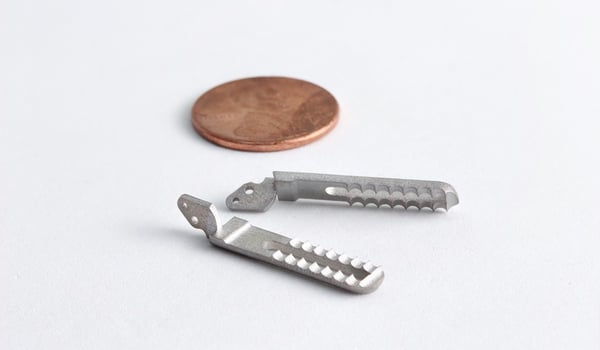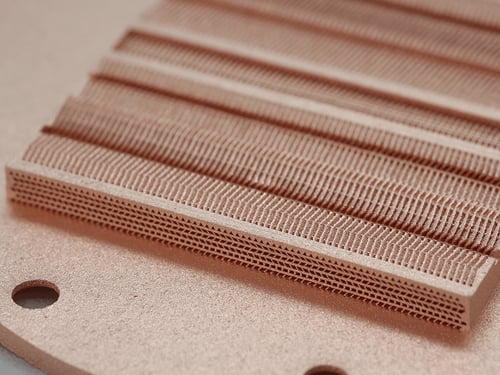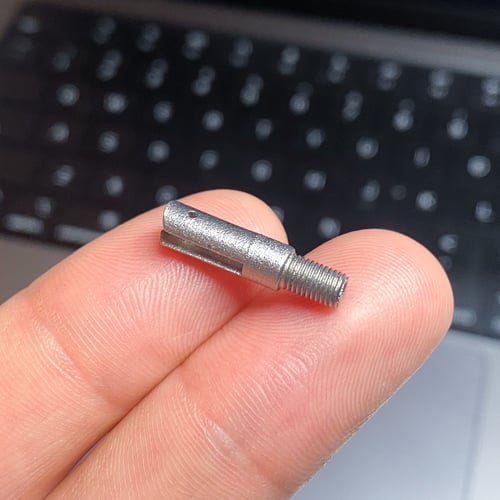5 characteristics of great parts for Holo's metal 3D printing process
It’s not enough to have the right tool — you have to pair it with the right job for true engineering success.
We’re often asked what makes a great use case for Holo’s PureForm™ metal 3D printing technology, and like most additive manufacturing (AM) processes, there’s a vast array of different applications that can be an excellent fit. Rather than attempt to list them all (a futile endeavor), we like to think about “when to work with Holo” as a series of overlapping filters.

These gripper prototypes for a laparoscopic surgical tool are great fit for printing with our PureForm™ metal 3D printing process because they're complex, require a high degree of accuracy, and can be rapidly iterated during their development process.
In our experience, our customers have the best outcomes when the metal components they’re looking to manufacture have at least the first two (and ideally more) of the following characteristics:
- Size: softball size or smaller parts
- Complexity: highly intricate parts with fine individual features
- Need for production agility: complex parts that are technical fits for high volume processes like MIM or die casting, but require more production flexibility than is possible with processes based on hard tooling
- High quality iteration at speed: development projects that need frequent, rapid design revisions of intricate components, while maintaining the precision and quality of machining or metal injection moldign (MIM)
- ‘Un-machinable’ features: part features that aren’t manufacturable with standard processes like machining e.g. extreme length:diameter ratio holes at small diameters, inaccessible internal geometries, pockets with sharp corners, etc.
Let’s dive into each of these in a little more detail.
Size
One of the easiest and most visible qualifiers is part size. We’ve consistently found that components that are softball size or smaller tend to be the most useful and valuable to many of our customers, although we can print and sinter larger parts as well.
In addition to this overall part size, the best applications for our technology also have tiny individual features. This combination of larger bulk part dimensions with near-microscopic individual features is a clear signal that a part is a good potential candidate for printing with our PureForm™ technology.
One of the reasons for this sweet spot in part size is that complex parts in the range of palm-size or smaller tend to have features that become more difficult to manufacture with traditional means — thin features are more likely to deflect under cutting loads and micro-CNC tooling can break more easily and might not be able to access deep pockets (see ‘Un-machinable’ features section).
Complexity
In general, the more complex and intricate the metal part the more attractive it will be to print it with Holo. For traditional manufacturing processes, increasing part complexity typically drives increases in fixed costs like part setup and tool path programming time, and/or hard tooling lead times and costs, which all lead to higher individual part costs and longer overall lead times.
Holo’s PureForm™ metal 3D printing process is a digital manufacturing technology, where part geometries are formed by digital manipulation of an energy source (in our case a high definition, DLP-based digital projector) rather than requiring tooling, and our build software automatically creates printer machine instructions from a 3D CAD model. That means that no matter how complex the components you’re looking to produce (within a few simple constraints around min and max feature thickness), our software can quickly create a build file that’s ready to print.

An advanced cold plate for thermal management of high performance CPUs, printed in pure copper with Holo's PureForm™ process. Note the intricate flow channels enabled by 3D printing the cold plate.
Intricate parts also often have extremely small, fine part features and our PureForm™ process is extremely capable in this regard too. We can build parts with precise features as small as 50 µm (0.002 in), including microscopic linkages, slots and channels, interface and mating features, fine motion control components, textured surfaces and more.
Need for production agility
We frequently work with engineers who are developing components with complex geometries that would be ideal for the capabilities of high volume manufacturing processes like metal injection molding (MIM), or die or investment casting — except that they want to avoid the costs and multiple months delays in production incurred by producing tooling for those processes. This might be because they’re prototyping different designs, or testing a product in a new market before eventually moving to mass manufacturing processes, or they simply may be working on a program that needs to scale up and get to market faster than tooling-based processes allow.
In these situations, our metal 3D printing service is a powerful and cost-effective production tool. Our technology can match (and exceed) the capabilities of MIM and casting for complex geometries, and we can deliver those parts many times faster and more affordably, typically in quantities from a few parts well into the tens or hundreds of thousands of units.
Holo production customers gain the flexibility to update and adjust part designs without major costs, even in the midst of a production run. When working with traditional manufacturing processes based on hard tooling, even minor part design changes can result in expensive tooling rework or replacement. In contrast, since our PureForm™ technology is a digital manufacturing process, we can simply run an updated CAD model through our software pipeline and begin manufacturing the new design in our next build of parts.
High quality iteration at speed
A common refrain amongst our customers is that moving through prototype design cycles quickly and getting to market faster both eases the headache of development hell and is a massive competitive advantage. This is especially true when they’re working on projects and parts with tight dimensional requirements and intricate geometries, that have previously required long-lead time processes like five-axis machining, Swiss-type turning, or processes that require tooling.

Parts like this clevis for a surgical tool are often manufactured via turning, either on a Swiss-type or turret lathe with live tooling. Vendors with these capabilities often have long lead times, and can't meet the demands of rapid iterations needed for nimble product development.
Engineers turn to our metal 3D printing service for these types of applications, because our technology can deliver rapid incremental design iterations for complex parts in days instead of weeks. This is once again a benefit of using a digital manufacturing technology — with minimal machine setup, no tooling, and machine programming handled automatically in software, we can quickly add new orders into our production schedule and deliver your parts to you fast.
Speed isn’t everything however — the best applications for our technology arise from projects when engineers and designers need both rapid turnaround and highly accurate parts, often when those parts are part of precision assemblies. We’ve invested heavily over the years in optimizing our technology for the boring stuff — highly repeatable process control, dimensional accuracy, high surface finish, and post-sinter inspection to check our work. The result is that we produce highly accurate parts with typical tolerances of ±25 µm (±0.001 in) and typical surface finish of 1-3 µm Ra.
‘Un-machinable’ features
One of the lofty promises of 3D printing is that it can produce parts with geometries that are completely impossible to produce with any other manufacturing process. While this type of use case is less frequently seen, our PureForm™ process can be a good fit for these types of advanced components, which often enable breakthrough technologies.
We find that it’s less common for our customers to come to us initially with these types of applications, since as engineers we tend to design parts with a known manufacturing process in mind. However, we partner closely with our customers on design to get the most from our technology, and many come back to us over time with geometries specifically designed to take advantage our metal 3D printing process.
The layer-by-layer nature of the printing process creates opportunities for geometries not available through subtractive manufacturing processes, including integral holes and complex channels. These types of features can unlock brand new capabilities in a wide range of engineering applications — like integral cable routing in surgical tools, or internal turbulence-inducing mixing geometries in advanced heat sinks.
—
Does one of your projects sound like it might be a good fit? Talk with one of our experts and let’s see if we can help!

